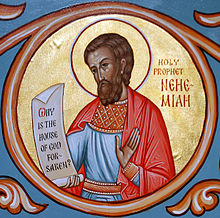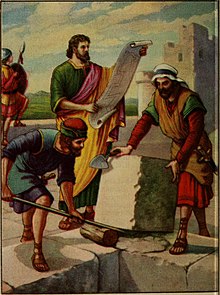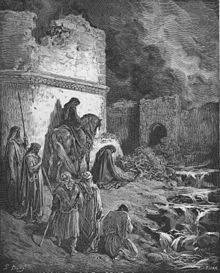| Revision as of 01:25, 5 February 2023 edit49.186.28.196 (talk) Took out unnecessary informationTags: Reverted Mobile edit Mobile web edit← Previous edit | Revision as of 01:25, 5 February 2023 edit undoLilianaUwU (talk | contribs)Extended confirmed users, Page movers, Pending changes reviewers, Rollbackers41,692 editsm Reverted edits by 49.186.28.196 (talk) to last version by Pisarz12345Tags: Rollback Disambiguation links addedNext edit → | ||
| Line 1: | Line 1: | ||
| {{Short description|Central figure of the biblical Book of Nehemiah}} | |||
| {{Other uses}} | |||
| {{Use dmy dates|date=June 2020}} | |||
| {{Infobox saint|name=Nehemias|image=Prophet nehemiah.jpg|caption=Greek icon|titles=Saint, Leader of the Israelites, Prophet|feast_day=13 July |honored_in=], ]}} | |||
| ] | |||
| '''Nehemiah''' is the central figure of the ], which describes his work in rebuilding Jerusalem during the ]. He was governor of ] under ] (465–424 BC).<ref name="GHCL"/><ref name="DunnRogerson2003">{{cite book|author1=James D. G. Dunn|author2=John William Rogerson|title=Eerdmans Commentary on the Bible|url=https://books.google.com/books?id=2Vo-11umIZQC&pg=PA321|date=19 November 2003|publisher=Wm. B. Eerdmans Publishing|isbn=978-0-8028-3711-0|page=321|access-date=10 August 2019|archive-date=14 October 2020|archive-url=https://web.archive.org/web/20201014083759/https://books.google.com/books?id=2Vo-11umIZQC&pg=PA321|url-status=live}}</ref> The name is pronounced {{IPAc-en|ˌ|n|iː|ə|ˈ|m|aɪ|ə}} or {{IPAc-en|ˌ|n|iː|h|ə|ˈ|m|aɪ|ə}} in English. It is in Hebrew {{Script/Hebrew|נְחֶמְיָה}}, ''Nəḥemyāh'', "] comforts".<ref name="GHCL">{{cite book|last1=Gesenius|first1=Friedrich Wilhelm|title=Gesenius' Hebrew-Chaldee Lexicon|date=1846|publisher=Baker Book House; 7th edition, 1979|isbn=0801037360|page=|url=http://www.tyndalearchive.com/tabs/Gesenius/|access-date=16 April 2015|archive-date=1 December 2018|archive-url=https://web.archive.org/web/20181201185220/http://www.tyndalearchive.com/TABS/Gesenius/|url-status=live}}</ref> | |||
| Most scholars believe Nehemiah was a real historical figure and that the Nehemiah Memoir, a name given by scholars to certain portions of the book written in the first person, is historically reliable.<ref name="RodgersDaly-Denton2009">For confirmation that many scholars share this view, see {{cite book|editor1=Zuleika Rodgers|editor2=Margaret Daly-Denton|editor3=Anne Fitzpatrick Mckinley|author=Anne Fitzpatrick|title=''"What did Nehemiah do for Judaism," in'' A Wandering Galilean: Essays in Honour of Seán Freyne|url=https://books.google.com/books?id=5I8zfmwEjjUC&pg=PA93|year=2009|publisher=BRILL|isbn=978-90-04-17355-2|pages=93–}}</ref><ref name="MorWinkler2010">For confirmation that most scholars share this view, see {{cite book|editor1=Menahem Mor|editor2=Friedrick V. Reiterer|author=Jack Pastor|title=''"The Contribution of the Samaria Papyri from Wadi Daliyeh to the Study of Economics in the Persian Period," in'' Samaritans: Past and Present: Current Studies|url=https://books.google.com/books?id=yKuN9_ZTvHEC&pg=PA52|year=2010|publisher=Walter de Gruyter|isbn=978-3-11-019497-5|pages=52–}}</ref><ref name="Davies2014">For an author who disagrees with the scholarly majority position on the historicity of Nehemiah and Ezra, but acknowledges the existence of that majority, see {{cite book|author=Philip R. Davies|title=Rethinking Biblical Scholarship: Changing Perspectives 4|url=https://books.google.com/books?id=QFdsBAAAQBAJ&pg=PT108|date=3 September 2014|quote=The essential historicity of the events described has rarely been questioned.|publisher=Taylor & Francis|isbn=978-1-317-54443-2|page=108|access-date=8 September 2017|archive-date=15 February 2017|archive-url=https://web.archive.org/web/20170215005011/https://books.google.com/books?id=QFdsBAAAQBAJ&pg=PT108|url-status=live}}</ref> | |||
| '''Nehemiah''' is the central figure of the ], which describes his work in rebuilding Jerusalem during the ]. He was governor of [[Yehud Medinata|Persian | |||
| ==Book of Nehemiah narrative== | ==Book of Nehemiah narrative== | ||
Revision as of 01:25, 5 February 2023
Central figure of the biblical Book of Nehemiah For other uses, see Nehemiah (disambiguation).
| Nehemias | |
|---|---|
 Greek icon Greek icon | |
| Saint, Leader of the Israelites, Prophet | |
| Honored in | Catholic Church, Eastern Orthodox Church |
| Feast | 13 July |

Nehemiah is the central figure of the Book of Nehemiah, which describes his work in rebuilding Jerusalem during the Second Temple period. He was governor of Persian Judea under Artaxerxes I of Persia (465–424 BC). The name is pronounced /ˌniːəˈmaɪə/ or /ˌniːhəˈmaɪə/ in English. It is in Hebrew נְחֶמְיָה, Nəḥemyāh, "Yah comforts".
Most scholars believe Nehemiah was a real historical figure and that the Nehemiah Memoir, a name given by scholars to certain portions of the book written in the first person, is historically reliable.
Book of Nehemiah narrative

In the 20th year of Artaxerxes I (445 or 444 BC), Nehemiah was cup-bearer to the king. Learning that the remnant of Jews in Judah were in distress and that the walls of Jerusalem were broken down, he asked the king for permission to return and rebuild the city, around 20 years after Ezra's arrival in Jerusalem in 468 BC. Artaxerxes sent him to Judah as governor of the province with a mission to rebuild, letters explaining his support for the venture, and provision for timber from the king's forest. Once there, Nehemiah defied the opposition of Judah's enemies on all sides—Samaritans, Ammonites, Arabs and Philistines—and rebuilt the walls within 52 days, from the Sheep Gate in the North, the Hananeel Tower at the North West corner, the Fish Gate in the West, the Furnaces Tower at the Temple Mount's South West corner, the Dung Gate in the South, the East Gate and the gate beneath the Golden Gate in the East.
Appearing in the Queen's presence may indicate that he was a eunuch, and in the Septuagint, the Greek translation of the Hebrew Bible, he is described as such: eunochos (eunuch), rather than oinochoos (wine-cup-bearer). If so, the attempt by his enemy Shemaiah to trick him into entering the Temple is aimed at making him break Jewish law, rather than simply hide from assassins.
He then took measures to repopulate the city and purify the Jewish community, enforcing the cancellation of debt, assisting Ezra in promulgating the law of Moses, and enforcing the divorce of Jewish men from their non-Jewish wives.

After 12 years as governor, during which he ruled with justice and righteousness, he returned to the king in Susa. After some time in Susa he returned to Jerusalem, only to find that the people had fallen back into their evil ways. Non-Jews were permitted to conduct business inside Jerusalem on the Sabbath and to keep rooms in the Temple. Greatly angered, he purified the Temple and the priests and Levites and enforced the observance of the law of Moses.
Book of Maccabees
The Second Book of Maccabees says Nehemiah is the one who brought the holy fire for the altar back from the diaspora to Jerusalem and founded a library of the Holy Scriptures just as Judas Maccabeus did. Here, Nehemiah’s political role sets an example for the Hasmonean dynasty and becomes a role model for pious, national leadership in general. The scene of reading and explaining the Torah in Neh 8 became the model of synagogue worship. See 2 Maccabees 2:13.
Book of Sirach
Ben Sira’s hymn in praise of the fathers mentions only Nehemiah (not Ezra) after Zerubbabel and Joshua and praises him for his building activities (Sir 49:15).
In rabbinic literature
One rabbinic text, or aggadah, identifies Nehemiah as Zerubbabel, with the latter being considered an epithet and indicating that he was born in Babylon. Another oral tradition, or mishnah, records that Nehemiah was blamed for seeming to boast (Neh. v. 19 & xiii. 31), and disparage his predecessors (Neh. v. 15). This tradition asserts that his book was appended to the Book of Ezra, as a consequence, rather than being a separate book in its own right, as it is in the Christian Old Testament. Another Talmudic text, or Baba Bathra, records that Nehemiah completed the Book of Chronicles, which was said to have been written by Ezra.
In art
| This section needs expansion. You can help by adding to it. (May 2019) |
Samuel Taylor Coleridge commented on the dearth of a classical painting featuring Nehemiah.
Veneration
Nehemias is venerated in Catholic Church and Orthodox Church:
- 13 July – commemoration (Catholic Church),
- Sunday of the Forefathers – movable holiday on Sunday that falls between December 11-17.
See also
References
- ^ Gesenius, Friedrich Wilhelm (1846). Gesenius' Hebrew-Chaldee Lexicon. Baker Book House; 7th edition, 1979. p. 544. ISBN 0801037360. Archived from the original on 1 December 2018. Retrieved 16 April 2015.
- James D. G. Dunn; John William Rogerson (19 November 2003). Eerdmans Commentary on the Bible. Wm. B. Eerdmans Publishing. p. 321. ISBN 978-0-8028-3711-0. Archived from the original on 14 October 2020. Retrieved 10 August 2019.
- For confirmation that many scholars share this view, see Anne Fitzpatrick (2009). Zuleika Rodgers; Margaret Daly-Denton; Anne Fitzpatrick Mckinley (eds.). "What did Nehemiah do for Judaism," in A Wandering Galilean: Essays in Honour of Seán Freyne. BRILL. pp. 93–. ISBN 978-90-04-17355-2.
- For confirmation that most scholars share this view, see Jack Pastor (2010). Menahem Mor; Friedrick V. Reiterer (eds.). "The Contribution of the Samaria Papyri from Wadi Daliyeh to the Study of Economics in the Persian Period," in Samaritans: Past and Present: Current Studies. Walter de Gruyter. pp. 52–. ISBN 978-3-11-019497-5.
- For an author who disagrees with the scholarly majority position on the historicity of Nehemiah and Ezra, but acknowledges the existence of that majority, see Philip R. Davies (3 September 2014). Rethinking Biblical Scholarship: Changing Perspectives 4. Taylor & Francis. p. 108. ISBN 978-1-317-54443-2. Archived from the original on 15 February 2017. Retrieved 8 September 2017.
The essential historicity of the events described has rarely been questioned.
- On the date, see Ezra-Nehemiah: A Commentary. Westminster John Knox Press. 1 January 1988. p. 140. ISBN 978-0-664-22186-7.
- Nehemiah 1:11
- Nehemiah 1:1-2:5
- Davies, G. I., Introduction to the Pentateuch in Barton, J. and Muddiman, J. (2001), The Oxford Bible Commentary Archived 22 November 2017 at the Wayback Machine, p. 19
- Nehemiah 2:6-9
- Nehemiah 2:6
- R. J. Coggins. The books of Ezra and Nehemiah (Cambridge: Cambridge University Press, 1976), 73; also F. Charles Fensham, The Books of Ezra and Nehemiah (Grand Rapids, MI: Eerdmans, 1982), 140
- John Barton, The Oxford Bible commentary, Oxford University Press, 2001
- Bergren, Theodore A. "Nehemiah in 2 Maccabees 1:10-2:18". Journal for the Study of Judaism in the Persian, Hellenistic, and Roman Period, vol. 28, no. 3, 1997, pp. 249–270. JSTOR 24668403. Retrieved 2 May 2020.
- Nehemiah by Emil G. Hirsch, David Samuel Margoliouth, Wilhelm Bacher & M. Seligsohn, in "The Jewish Encyclopedia: A Descriptive Record of the History, Religion, Literature, and Customs of the Jewish People from the Earliest Times to the Present Day", Funk & Wagnalls, New York 1901-6.
- Paley, Morton D. (10 July 2008). Samuel Taylor Coleridge and the Fine Arts. OUP Oxford. ISBN 9780191552724. Archived from the original on 26 August 2022. Retrieved 2 April 2018 – via Google Books.
- Zeno. "Lexikoneintrag zu »Neemias (1)«. Vollständiges Heiligen-Lexikon, Band 4. Augsburg ..." www.zeno.org (in German). Retrieved 3 February 2023.
- "Святой Нееми́я, вождь иудейский". Православный Церковный календарь (in Russian). Retrieved 3 February 2023.
 This article incorporates text from a publication now in the public domain: Easton, Matthew George (1897). "Nehemiah". Easton's Bible Dictionary (New and revised ed.). T. Nelson and Sons.
This article incorporates text from a publication now in the public domain: Easton, Matthew George (1897). "Nehemiah". Easton's Bible Dictionary (New and revised ed.). T. Nelson and Sons.
Further reading
- Barr, James. "History of Israel" in History and Ideology in the Old Testament (Oxford: Oxford University Press, 2000), 87
- Holman Bible Dictionary, "Persia"
- Cataldo, Jeremiah. "Memory Trauma in Ezra-Nehemiah" in David Chalcraft, ed., Methods, Theories and Imagination: Social Scientific Approaches in Biblical Studies, Sheffield: Sheffield Phoenix Press, 2014, pp. 147–57.
- Lester Grabbe. Ezra, in Eerdmans Commentary on the Bible (ed. James D. G. Dunn, John William Rogerson, Eerdmans, 2003) pp. 320–1
- Pakkala, Juha. "Ezra the scribe: the development of Ezra 7–10 and Nehemiah 8" (Walter de Gruyter, 2004). pp. 225–7
- Schulte, Lucas L. My Shepherd, Though You Do Not Know Me: The Persian Royal Propaganda Model in the Nehemiah Memoir (Leuven: Peeters, 2016), 197–204.
- Williamson, H. G. M. Ezra and Nehemiah (Sheffield: Sheffield Academic Press, 1987), 17
- Wright, Jacob. "Rebuilding identity: the Nehemiah-memoir and its earliest readers" (Walter de Gruyter, 2004). p. 340.
External links
- "Nehemiah" in The Jewish Encyclopedia
- "The Wall that Nehemiah Built", Biblical Archaeology Review
- Israel Finkelstein. "Jerusalem in the Persian (and Early Hellenistic) Period and the Wall of Nehemiah"
- Israel Finkelstein. "Archaeology and the List of Returnees in the Books of Ezra and Nehemiah"
- Hebrew Bible people
- Biblical figures in rabbinic literature
- Ezra–Nehemiah
- 5th-century BCE Jews
- Satraps of the Achaemenid Empire
- Cup-bearers
- Biblical patriarchs
- Book of Numbers people
- Christian saints in unknown century
- Roman Catholic royal saints
- Eastern Orthodox royal saints
- Urban planners
- Israeli urban planners
- Prophets in Christianity
- Prophets of the Hebrew Bible
- Christian saints from the Old Testament
- Persian saints
- Christian royal saints